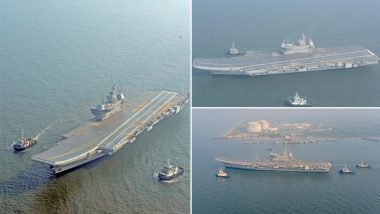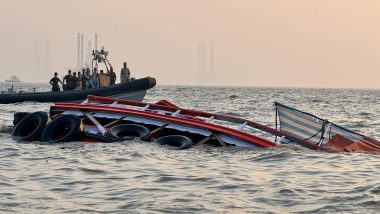India’s most complex warship – Indigenous Aircraft Carrier (IAC) ‘Vikrant’, recently completed its 4th phase of sea trial and the 40,000-tonne warship is all set to enter into service in August 2022. The landmark development is a massive achievement for India, as the nation will join a league of nations capable of designing and building an Aircraft Carrier.
The sea trials of the largest warship built in the country involved the testing performance of the critical equipment and systems relating to onboard aviation facilities. Further, integrated trials of key aviation equipment was also undertaken to enhance the performance, towards delivery of the largest indigenous warship in Azadi Ka Amrit Mahotsav.
The largest and most complex warship of India IAC Vikrant is a shining example in the nation’s quest for ‘Atmanirbhar Bharat’ and ‘Make in India Initiative’. The success story of IAC has numerous counts, let’s dive-in the many folds of Vikrant.
Inside the World India’s Own IAC Vikrant
With 76 percent of indigenous content in construction, IAC Vikrant has a large number of Made-in-India materials such as steel, besides other equipment manufactured by Indian industrial houses. Notably, around 550 Indian firms including about 100 MSMEs have provided various services for construction of IAC.
Built at India’s largest shipbuilding and maintenance facility ‘Cochin Shipyard Limited’ (CSL) by more than 2,000 CSL personnel along with 12,000 employees in ancillary industries. The design of IAC Vikrant was developed by the Indian Navy’s Directorate of Naval Design(DND). IAC Vikrant Completes Fourth Sea Trial.
It is pertinent to note that the indigenous construction of the carrier has generated immense employment opportunities and bolstered plough back effect in the economy. In totality, close to 2,000 shipyards and 13,000 non-yard personnel have been employed per annum towards construction of IAC.
Currently codenamed as IAC-1, IAC Vikrant once it enters service in the Indian Navy, will provide the essential requirement of an aircraft carrier in an airfield at sea. It is a warship with a long, flat deck for fighter jets to take off and land. Often it is the flagship that spearheads a battle group and is escorted by destroyers, frigates, and submarines to shield it from any attack.
With its induction, the warship will be a key component of the Indian Navy’s push to establish itself as a “blue water” force – a force with an ability to project its power on distant seas. It is especially important amid India’s bid to be a net security provider in the Indian Ocean region.
India’s Most Advanced Warship’s Maiden Sea Sortie
In August 2021, IAC Vikrant began sea trials off the coast of Kochi. The maiden attempt of the Indian Navy and CSL put India in the exclusive list of a handful of countries that have the capability to indigenously design and build an Aircraft Carrier.
Interestingly, the Indigenous Aircraft Carrier (IAC) will carry the name Indian Naval Ship (INS) Vikrant, the same as the Indian Navy’s first aircraft carrier that was decommissioned in 1997 after 35 years of glorious service to the nation.
The state-of-art IAC Vikrant is a mini floating city, with a flight deck area covering the size of two football fields. The ship is 262 m long, 62 m at the widest part, and has a height of 59 m including the superstructure. The ship comprises 14 decks in all along with five in the superstructure. Further, it has 2,300 compartments, designed to cater to a crew of around 1,700 people, including customized cabins to accommodate women officers.
For the first time in the country, the size of an Aircraft Carrier is completely modeled in 3D, and production drawings are extracted from the 3D model. Cochin Shipyard Limited carried out the detailed engineering of the ship using advanced technology which enabled the designer to get a complete 3D view of the compartments of the ship.
Notably, Vikrant has a top speed of around 28 knots and a cruising speed of 18 knots with an endurance of about 7,500 nautical miles. The ship can accommodate an assortment of fixed-wing and rotary aircraft.
The Operational Capability of IAC
LAC Vikrant has been designed to operate “an assortment of fixed-wing and rotary aircraft”. Further, it will carry the MiG-29K fighter jets, the indigenously manufactured Advanced Light Helicopters and the MH-60R multirole helicopter as per the Indian Navy.
The warship will also offer an “incomparable military instrument with its ability to project Air Power over long distances, including offensive, Air Interdiction, Anti-Surface Warfare, defensive Counter-Air, Airborne Anti-Submarine Warfare and Airborne Early Warning.
Does India Have Any Other Aircraft Carriers?
Presently, the Indian Navy has only one operational aircraft carrier as INS Vikramaditya. India’s two earlier aircraft carriers, INS Vikrant and INS Viraat, were originally the British-built HMS Hercules and HMS Hermes before being commissioned into the Navy in 1961 and 1987 respectively.
Notably, Vikrant has a top speed of around 28 knots and a cruising speed of 18 knots with an endurance of about 7,500 nautical miles. The ship can accommodate an assortment of fixed-wing and rotary aircraft.
The Operational Capability of IAC
LAC Vikrant has been designed to operate “an assortment of fixed-wing and rotary aircraft”. Further, it will carry the MiG-29K fighter jets, the indigenously manufactured Advanced Light Helicopters and the MH-60R multirole helicopter as per the Indian Navy. IAC Vikrant Sets Out For New Trials Ahead of Commissioning in 2022, Check Pics.
The warship will also offer an “incomparable military instrument with its ability to project Air Power over long distances, including offensive, Air Interdiction, Anti-Surface Warfare, defensive Counter-Air, Airborne Anti-Submarine Warfare and Airborne Early Warning.
Does India Have Any Other Aircraft Carriers?
Presently, the Indian Navy has only one operational aircraft carrier as INS Vikramaditya. India’s two earlier aircraft carriers, INS Vikrant and INS Viraat, were originally the British-built HMS Hercules and HMS Hermes before being commissioned into the Navy in 1961 and 1987 respectively.
(The above story first appeared on LatestLY on Jul 14, 2022 11:45 AM IST. For more news and updates on politics, world, sports, entertainment and lifestyle, log on to our website latestly.com).













 Quickly
Quickly





















